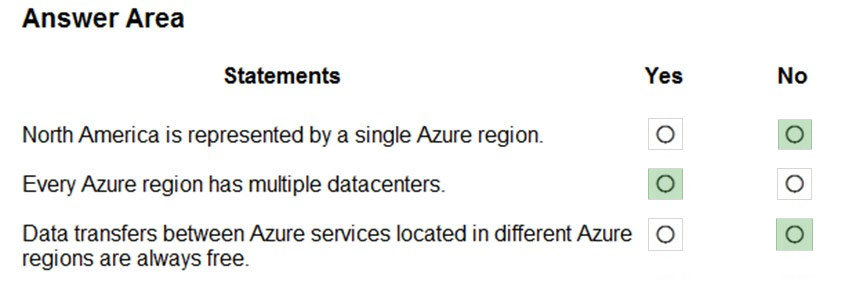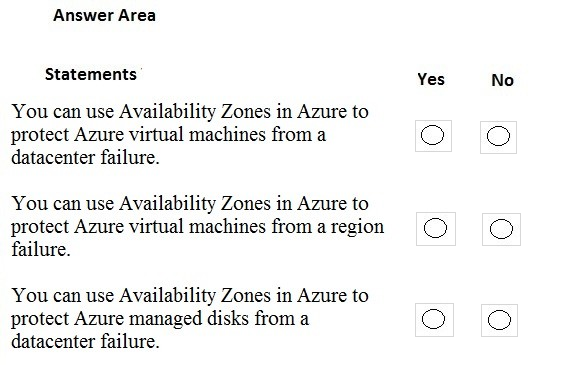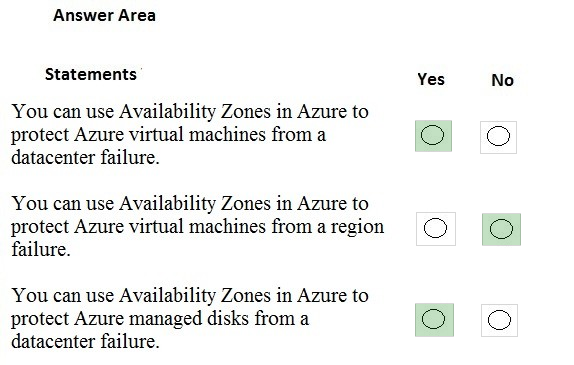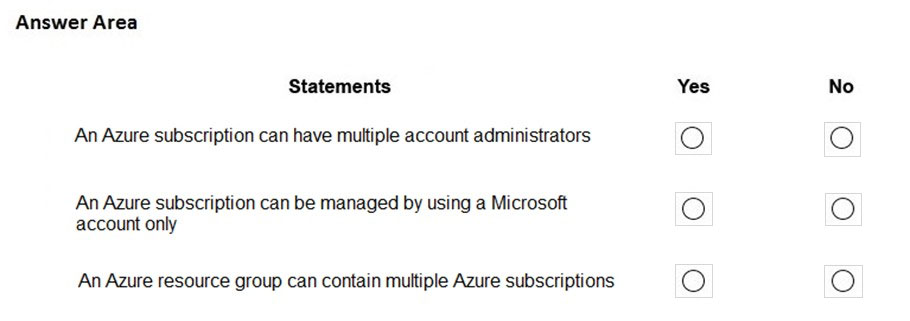HOTSPOT -
For each of the following statements, select Yes if the statement is true. Otherwise, select No.
NOTE: Each correct selection is worth one point.
Hot Area:
Answer:

Box 1: No -
North America has several Azure regions, including West US, Central US, South Central US, East Us, and Canada East.
Box 2: Yes -
A region is a set of datacenters deployed within a latency-defined perimeter and connected through a dedicated regional low-latency network.
Box 3: No -
Outbound data transfer is charged at the normal rate and inbound data transfer is free.
References:
https://azure.microsoft.com/en-us/global-infrastructure/regions/ https://azure.microsoft.com/en-us/pricing/details/bandwidth/
Note: This question is part of a series of questions that present the same scenario. Each question in the series contains a unique solution that might meet the stated goals. Some question sets might have more than one correct solution, while others might not have a correct solution.
After you answer a question in this section, you will NOT be able to return to it. As a result, these questions will not appear in the review screen.
You plan to deploy several Azure virtual machines.
You need to ensure that the services running on the virtual machines are available if a single data center fails.
Solution: You deploy the virtual machines to two or more scale sets.
Does this meet the goal?
Answer:
B
This answer does not specify that the scale set will be configured across multiple data centers so this solution does not meet the goal.
Azure virtual machine scale sets let you create and manage a group of load balanced VMs. The number of VM instances can automatically increase or decrease in response to demand or a defined schedule. Scale sets provide high availability to your applications, and allow you to centrally manage, configure, and update many VMs.
Virtual machines in a scale set can be deployed across multiple update domains and fault domains to maximize availability and resilience to outages due to data center outages, and planned or unplanned maintenance events.
Reference:
https://docs.microsoft.com/en-us/azure/virtual-machine-scale-sets/availability
You need to be notified when Microsoft plans to perform maintenance that can affect the resources deployed to an Azure subscription.
What should you use?
Answer:
B
Azure Service Health provides a personalized view of the health of the Azure services and regions you're using. This is the best place to look for service impacting communications about outages, planned maintenance activities, and other health advisories because the authenticated Service Health experience knows which services and resources you currently use.
Reference:
https://docs.microsoft.com/en-us/azure/service-health/overview
DRAG DROP -
Match the Azure Services service to the correct description.
Instructions: To answer, drag the appropriate service from the column on the left to its description on the right. Each service may be used once, more than once, or not at all.
NOTE: Each correct selection is worth one point.
Select and Place:
Answer:

Reference:
https://docs.microsoft.com/en-us/azure-sphere/product-overview/what-is-azure-sphere https://docs.microsoft.com/en-us/azure/iot-central/core/overview-iot-central https://docs.microsoft.com/en-us/azure/iot-hub/about-iot-hub
HOTSPOT -
For each of the following statements, select Yes if the statement is true. Otherwise, select No.
NOTE: Each correct selection is worth one point.
Hot Area:
Answer:

Reference:
https://docs.microsoft.com/en-us/azure/virtual-desktop/overview
HOTSPOT -
To complete the sentence, select the appropriate option in the answer area.
Hot Area:
Answer:

Reference:
https://blog.abouttmc.com/azure-cloud-total-cost-of-ownership
HOTSPOT -
For each of the following statements, select Yes if the statement is true. Otherwise, select No.
NOTE: Each correct selection is worth one point.
Hot Area:
Answer:

Availability zones expand the level of control you have to maintain the availability of the applications and data on your VMs. Availability Zones are unique physical locations within an Azure region. Each zone is made up of one or more datacenters equipped with independent power, cooling, and networking. To ensure resiliency, there are a minimum of three separate zones in all enabled regions. The physical separation of Availability Zones within a region protects applications and data from datacenter failures.
With Availability Zones, Azure offers industry best 99.99% VM uptime SLA. By architecting your solutions to use replicated VMs in zones, you can protect your applications and data from the loss of a datacenter. If one zone is compromised, then replicated apps and data are instantly available in another zone.
References:
https://docs.microsoft.com/en-us/azure/virtual-machines/windows/manage-availability
HOTSPOT -
For each of the following statements, select Yes if the statement is true. Otherwise, select No.
NOTE: Each correct selection is worth one point.
Hot Area:
Answer:

Box 1: No -
A subscription can have multiple administrators, but there can only be one account administrator.
Box 3: No -
A subscription can contain multiple resource groups but a resource group can only belong to one subscription. Resource groups can contain multiple resources.
Reference:
https://k21academy.com/microsoft-azure/az-900/az-900-azure-subscriptions/ https://azure.microsoft.com/en-us/blog/organizing-subscriptions-and-resource-groups-within-the-enterprise/
HOTSPOT -
To complete the sentence, select the appropriate option in the answer area.
Hot Area:
Answer:

A region is a set of data centres deployed within a latency-defined perimeter and connected through a dedicated regional low-latency network.
Microsoft Azure currently has 55 regions worldwide.
Regions are divided into Availability Zones. Availability Zones are physically separate locations within an Azure region. Each Availability Zone is made up of one or more datacenters equipped with independent power, cooling, and networking.
Reference:
https://azure.microsoft.com/en-gb/global-infrastructure/regions/
HOTSPOT -
For each of the following statements, select Yes if the statement is true. Otherwise, select No.
NOTE: Each correct selection is worth one point.
Hot Area:
Answer:

Reference:
https://docs.microsoft.com/en-us/azure/active-directory/enterprise-users/groups-dynamic-membership https://petri.com/understanding-hybrid-azure-active-directory-join